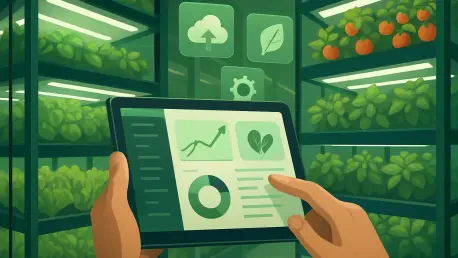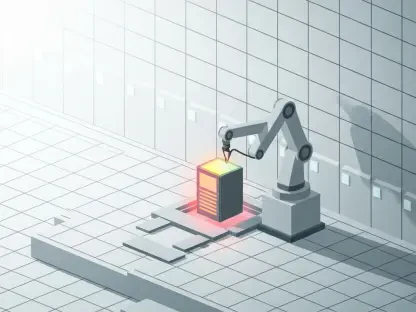Imagine a world where fresh, high-quality produce is grown year-round in the heart of urban centers, unaffected by weather extremes or land shortages, and where vertical farming, an innovative method of cultivating crops in stacked layers within controlled environments, makes this vision a reality. As global populations swell and arable land diminishes, the urgency for sustainable food production has never been greater. Agritech software, developed by pioneering companies like Intelligent Growth Solutions (IGS), stands at the forefront of this agricultural revolution. Far from being just a digital tool, this technology redefines how growers operate, offering precision, efficiency, and scalability. It addresses long-standing challenges of traditional farming by automating processes and optimizing resources, ensuring that every harvest is as predictable as the last. This transformation isn’t merely about growing plants—it’s about building a resilient food system capable of meeting tomorrow’s demands with innovative solutions that balance profitability and environmental stewardship.
The Power of Precision and Consistency
Automating Growth with Repeatability
Agritech software reshapes vertical farming by introducing a level of repeatability that traditional methods could never achieve. Through features like “Growth Recipes,” which are carefully calibrated sets of environmental conditions including water levels, light spectra, and nutrient blends, growers can replicate ideal growing scenarios with stunning accuracy. This automation eliminates the variability often caused by human error, ensuring that each crop cycle yields consistent results. Such predictability allows farmers to plan harvests and deliveries with confidence, aligning production schedules with market needs. The ability to maintain uniformity across batches not only enhances product quality but also builds trust with buyers who rely on steady supply chains. By taking the guesswork out of cultivation, this technology creates a foundation for vertical farming operations that are both reliable and scalable, setting a new standard for agricultural precision in controlled environments.
Beyond the immediate benefits of consistency, the impact of automated repeatability extends to long-term business planning. Growers equipped with agritech software can forecast growth timelines with precision, enabling better inventory management and reducing the risk of overproduction or shortages. This forward-looking capability is particularly vital in an industry where timing can make or break profitability. Additionally, the software’s ability to store and replicate successful recipes means that once an optimal formula is discovered, it can be applied indefinitely without deviation. This reduces the learning curve for new operators and minimizes costly trial-and-error phases. As vertical farms expand to meet rising food demands, having a system that guarantees uniform output across multiple facilities becomes a game-changer, ensuring that quality remains uncompromised regardless of scale or location. The marriage of automation and agriculture through such software paves the way for a more dependable food production model.
Data-Driven Refinement
The role of data in agritech software cannot be overstated, as it serves as the backbone for continuous improvement in vertical farming. By collecting thousands of data points daily—from temperature fluctuations to nutrient absorption rates—the software provides a wealth of information that growers can use to refine their practices. These insights allow for the ongoing adjustment of Growth Recipes, ensuring that each cycle is more efficient than the last. Unlike traditional farming, where changes often come after visible crop failures, this proactive approach identifies potential issues before they escalate, safeguarding yields. The result is a growing environment that evolves in real-time, adapting to subtle shifts in conditions to maximize output and quality. This data-driven methodology transforms vertical farming into a science of precision, where every decision is informed by hard evidence rather than intuition.
Moreover, the seamless integration of data analytics into daily operations ensures that improvements happen without disrupting production. Frequent software updates, rolled out incrementally, incorporate the latest findings and technological advancements, keeping growers at the cutting edge without downtime. This agility is critical in an industry where consumer preferences and environmental factors can shift rapidly. The ability to analyze vast datasets also helps identify trends that might otherwise go unnoticed, such as the optimal light spectrum for a specific crop variety. By turning raw data into actionable strategies, agritech software empowers farmers to push the boundaries of productivity while maintaining a tight grip on operational stability. As vertical farming continues to gain traction globally, the reliance on data as a tool for refinement will only grow, positioning this technology as an indispensable asset for sustainable agriculture.
Boosting Efficiency and Accessibility
Simplifying Complex Operations
One of the most transformative aspects of agritech software in vertical farming is its ability to streamline complex operations into manageable tasks. Designed with intuitive interfaces by user experience experts, the software demystifies the intricate hardware and environmental controls that define controlled-environment agriculture. This means that operators, even those without advanced technical training, can manage sophisticated systems with ease. By reducing the need for extensive specialized knowledge, the technology lowers the barrier to entry for new growers and cuts down on the size of teams required for day-to-day management. Instead of spending hours on manual monitoring or troubleshooting, staff can focus on higher-value activities like market analysis or crop innovation. This shift not only boosts operational efficiency but also makes vertical farming more accessible to a broader range of stakeholders.
The ripple effects of simplified operations are felt in the bottom line as well. With fewer personnel needed to oversee routine tasks, labor costs are significantly reduced, allowing businesses to allocate resources to areas that drive growth. Additionally, the user-friendly nature of the software minimizes training time, enabling new employees to get up to speed quickly and contribute effectively. This efficiency is especially critical for vertical farms operating in urban settings, where space and labor costs are often at a premium. By transforming what could be an overwhelming array of dials and data into straightforward commands, agritech software ensures that the focus remains on producing high-quality crops rather than wrestling with technology. As a result, vertical farming becomes not just a niche experiment but a practical, scalable solution for food production in diverse settings around the world.
Resource Optimization for Sustainability
Agritech software also plays a pivotal role in optimizing resource use, a cornerstone of sustainable vertical farming. By providing detailed estimates for energy consumption and fine-tuning the delivery of water and nutrients, the technology ensures that nothing goes to waste. This precision reduces operational expenditures while maintaining high crop yields, striking a balance between profitability and environmental responsibility. For instance, the software can adjust irrigation schedules based on real-time plant needs, preventing overwatering and conserving a precious resource. Similarly, energy usage for lighting and climate control is calculated to avoid excess, aligning with broader goals of reducing carbon footprints. This meticulous approach to resource management positions vertical farming as a greener alternative to conventional methods, appealing to both eco-conscious consumers and regulators.
Furthermore, the sustainability benefits of resource optimization extend to long-term viability for growers. Lower input costs mean that vertical farms can remain competitive even in markets with tight margins, fostering economic resilience. The software’s ability to track and analyze resource usage also provides transparency, enabling operators to demonstrate their commitment to sustainable practices—a growing demand in today’s food industry. Beyond immediate savings, this focus on efficiency helps mitigate the environmental impact of scaling operations, ensuring that as vertical farming grows, it does so responsibly. In regions facing water scarcity or energy constraints, such technology becomes not just advantageous but essential, offering a blueprint for how agriculture can adapt to pressing global challenges. The synergy of cost-effectiveness and ecological mindfulness underscores the transformative potential of agritech in reshaping food production.
Seamless Integration and Scalability
Connecting to the Bigger Picture
Vertical farming does not exist in a vacuum, and agritech software ensures it integrates seamlessly into the broader agricultural ecosystem. Through secure public API layers, the technology communicates effectively with external systems such as manufacturing execution systems (MES) and supervisory control and data acquisition (SCADA) setups. This interoperability means that processes like seedling production, harvesting, and packaging flow without disruption, preventing bottlenecks even in high-throughput facilities. By behaving like standard equipment within larger operational frameworks, the software ensures that vertical farms can scale alongside other components of the food supply chain. This connectivity is crucial for growers aiming to meet the demands of large retailers or distributors, where timing and coordination are non-negotiable.
The importance of this integration becomes even clearer when considering the complexity of modern food production. Vertical farms often operate as part of intricate networks involving multiple stakeholders, from suppliers to logistics providers. Agritech software bridges these gaps, ensuring that data and commands move fluidly between systems to maintain efficiency at every stage. This capability prevents the technology from becoming an isolated silo, instead positioning it as a collaborative tool that enhances overall productivity. For businesses looking to expand their operations, such seamless connectivity offers the flexibility to incorporate new processes or partners without overhauling existing setups. As the industry evolves, this adaptability will be key to maintaining competitiveness in a landscape where integration often determines success over standalone innovation.
Adapting to Market Demands
Flexibility is another standout feature of agritech software, allowing vertical farmers to respond swiftly to changing market dynamics. The ability to adjust growth durations or tweak environmental conditions through pre-programmed recipes means that growers can align production with consumer demand or seasonal trends. For example, if a retailer requests a faster turnaround for a specific crop, operators can modify the growth cycle without sacrificing quality. This agility ensures that vertical farms remain competitive suppliers, capable of meeting tight deadlines or unexpected surges in orders. Such responsiveness is a stark contrast to traditional farming, where external factors often dictate output, leaving little room for adaptation.
This adaptability also empowers growers to experiment with new crop varieties or growing techniques without significant risk. Agritech software provides a controlled framework for testing adjustments, capturing data on outcomes to inform future decisions. This iterative process fosters innovation while maintaining operational stability, a balance that is critical for staying ahead in a fast-paced industry. Additionally, the capacity to tailor production to specific market needs enhances customer satisfaction, as growers can deliver exactly what is required when it is required. As global food systems face increasing pressure from population growth and climate challenges, the ability to pivot quickly through technological support becomes a defining advantage for vertical farming operations worldwide.
A Vision for the Future of Food Production
Leading the Charge in Precision Agriculture
Agritech software has emerged as a driving force in precision agriculture, fundamentally altering how vertical farming addresses global food security. By leveraging automation and data analytics, it maximizes productivity while curbing resource waste, aligning perfectly with the industry’s push toward controlled environment solutions. Its ability to deliver consistent, high-quality yields in compact spaces proves invaluable in urban areas where traditional farming is impractical. This technology not only meets immediate food needs but also sets a benchmark for sustainable practices, showing that efficiency and environmental care can coexist. Reflecting on its impact, the shift it has catalyzed in agricultural paradigms stands as a testament to the power of innovation in tackling pressing challenges.
Building a Sustainable Path Forward
Looking back, the adoption of agritech software in vertical farming marked a pivotal moment in balancing profitability with ecological responsibility. As growers integrated these tools, they found actionable ways to reduce energy and water usage through precise monitoring and adjustments. Moving ahead, the focus should remain on expanding access to such technologies, ensuring smaller operators can harness their benefits through affordable, scalable solutions. Collaboration between tech developers and agricultural stakeholders will be essential to refine systems further, addressing unique regional needs. Ultimately, the legacy of this software lies in its capacity to inspire a future where food production adapts seamlessly to global demands, safeguarding resources for generations to come.









